Your Complete Guide to Tokyo International Cruise Terminal: Address, Station Access & What’s Nearby
2025.11.25更新

If you’re planning a cruise from Tokyo, you might be wondering:
- How do I navigate a foreign city with a language barrier?
- What’s the easiest way to find the cruise terminal without getting lost?
- Where can I discover memorable spots near the terminal to make my visit truly special?
You’re not alone—and I’m here to help.
Tokyo International Cruise Terminal opened in 2020, but here’s the thing: access from major stations isn’t exactly convenient. If this is your first visit to Japan, navigating your way there can feel overwhelming. The last thing you want is stress before your cruise even begins.

Hi there! I’m Aoi from Cruise Aoi. I’m your navigator for “Japan-cruise BLOG”
As the founder of Cruise Aoi, I’ve personally guided over 5,000 travelers through their perfect Japanese cruise adventures—so I know exactly what works and what doesn’t.
That’s exactly why I’ve put together this guide. I’ll walk you through everything you need: the exact address, the easiest route from the nearest station, and the best spots to explore nearby before or after your cruise.
By the end of this article, you’ll know exactly how to reach the terminal without language barriers or getting lost. Even better, you’ll discover how to turn those few hours before your cruise into something truly memorable.
With this complete guide in hand, you can say goodbye to any worries about Tokyo International Cruise Terminal and start your voyage with confidence and excitement.
How to Get to Tokyo International Cruise Terminal: Address & Station Access
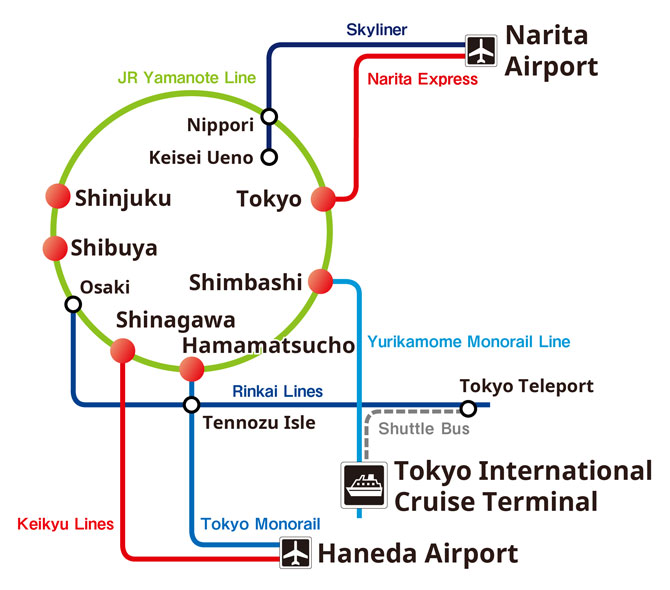
お台場エリアには、りんかい線(臨海線) と ゆりかもめ(ゆりかもめ線) の2つの鉄道路線が通っており、都心や空港からのアクセスもとても便利です。
Nearest Stations to Tokyo International Cruise Terminal
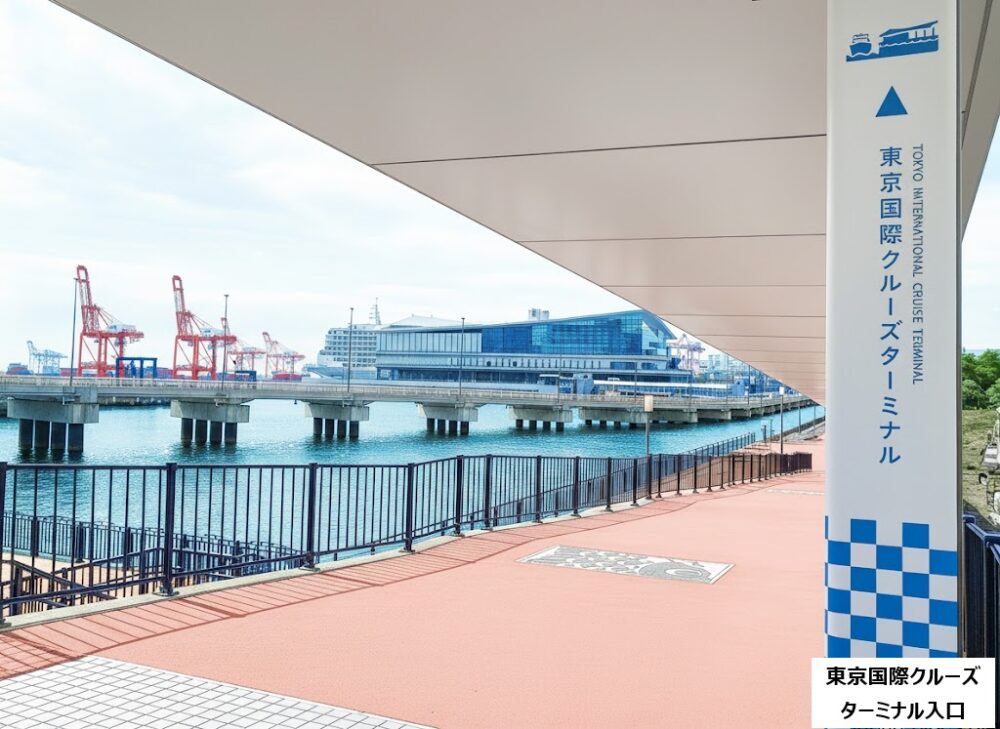
Yurikamome “Tokyo International Cruise Terminal Station”
This is the station on the Yurikamome Line—an elevated monorail that runs along Tokyo Bay with some pretty amazing waterfront views. From here, it’s about an 7-minute walk to the terminal. The best part? The station name matches the terminal name, so you won’t have to worry about getting confused.
The ride itself is an experience, you know. You’ll pass by Rainbow Bridge and enjoy stunning views of Odaiba’s waterfront—it’s quintessentially Tokyo. Many travelers actually look forward to this scenic journey as much as the cruise itself.
Here’s how to get to Tokyo International Cruise Terminal Station from major hubs:
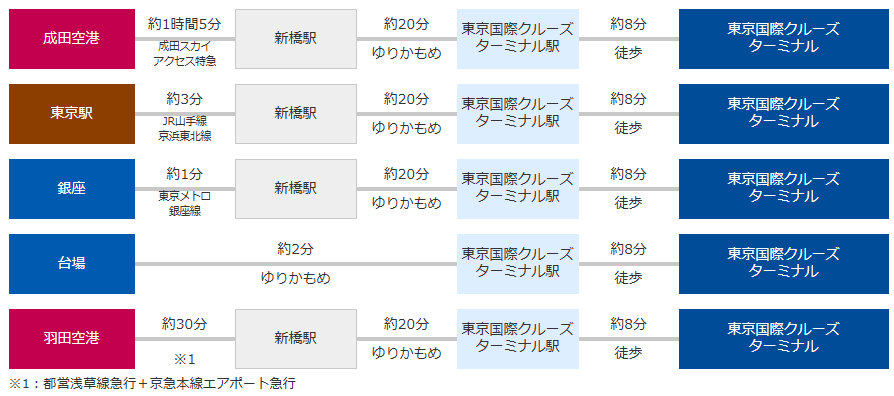
Rinkai Line “Tokyo Teleport Station”
Your other option is Tokyo Teleport Station on the Rinkai Line. From here, you can either walk to the terminal in about 15 minutes or take a bus that gets you there in roughly 10 minutes.
Here’s a helpful tip: when cruise ships are in port, a free shuttle bus runs between Tokyo Teleport Station and the cruise terminal. If you’re traveling with luggage—and let’s face it, most cruise passengers are—this is a real lifesaver.
Here’s how to reach Tokyo Teleport Station from major transit points:
Getting Around with the Free Shuttle Bus
When cruise ships are in port, a complimentary shuttle bus operates between Tokyo Teleport Station and Tokyo International Cruise Terminal. This is especially convenient if you’re traveling with large luggage—no need to drag your suitcases around!
Access from Major Stations to Tokyo International Cruise Terminal
Here’s how to reach Tokyo International Cruise Terminal Station (Yurikamome Line) & Tokyo Teleport Station(Rinkai Line) from major transit hubs:
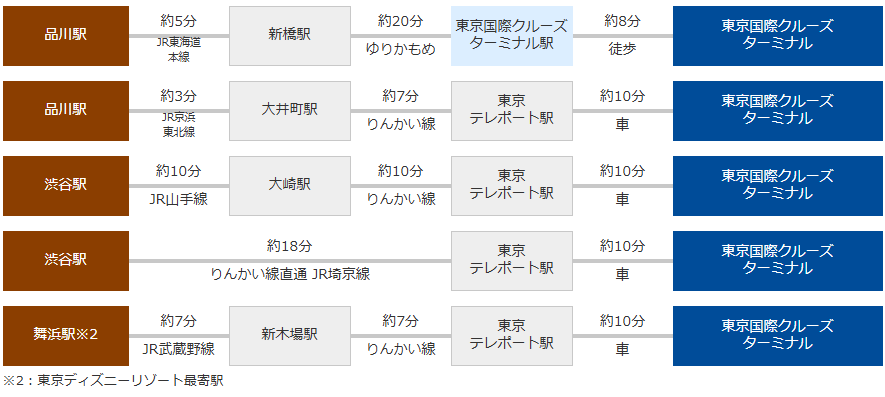
From Tokyo Station
The journey from Tokyo Station to Tokyo International Cruise Terminal takes about 30 minutes by public transportation—quick and easy.
| Transportation Method | Duration | Fare | Number of Transfers | Features |
|---|---|---|---|---|
| Train (JR Tokaido Line + Yurikamome) | 30 min | 540 yen | 1 transfer | Take the JR Tokaido Line to Shimbashi Station, then transfer to Yurikamome. |
| Train (JR Yamanote Line + Yurikamome) | 30 min | 540 yen | 1 transfer | Take the JR Yamanote Line to Shimbashi Station, then transfer to Yurikamome. |
| Train (JR Keiyo Line + Rinkai Line) | 37 min | 720 yen | 2 transfers | Take the JR Keiyo Line to Shin-Kiba Station, transfer to the Rinkai Line, then access on foot. |
| City Bus | 31 min | 200 yen | None | A direct bus runs from in front of Tokyo University of Marine Science and Technology Etchujima Campus, which is convenient. |
| Taxi | 25 min | 2,500 yen | None | Door-to-door transportation available. Ideal when carrying a lot of luggage or prioritizing comfort. |
From Haneda Airport
From Haneda Airport to Tokyo International Cruise Terminal, you’re looking at about 50 minutes by public transportation.
Airport Limousine Bus: The Comfortable Option
Both of Tokyo’s major airports—Haneda and Narita—offer direct limousine bus service to Tokyo International Cruise Terminal and hotels in the Odaiba area.
Let’s be honest: lugging heavy suitcases through train stations isn’t anyone’s idea of fun, especially after a long flight. The limousine bus lets you sit back, relax, and arrive at your destination without the hassle. It’s door-to-door convenience at its best.
| Transportation Method | Duration | Fare | Number of Transfers | Features |
|---|---|---|---|---|
| Train (Keikyu Line + Yurikamome) | 50 min | 940 yen | 1 transfer | Take the Keikyu Line to Shimbashi Station, then access via Yurikamome. |
| Train (Monorail + Rinkai Line) | 50 min | 1,000 yen | 1-2 transfers | Via Tennozu Isle Station by monorail, then to Tokyo Teleport Station by Rinkai Line. |
| Limousine Bus + Yurikamome | 40-50 min | 1,500 yen | None | Take the limousine bus to the Odaiba area (such as Hilton Tokyo Odaiba), then transfer to Yurikamome. |
| Taxi | 25 min | Approx. ¥4,000-¥5,000 | None | Door-to-door transportation available. Ideal when carrying a lot of luggage or prioritizing comfort. |
From Narita Airport
Getting from Narita Airport to Tokyo International Cruise Terminal takes anywhere from 1 to 2 hours by public transportation, depending on your route and connections.
| Transportation Method | Duration | Fare | Number of Transfers | Features |
|---|---|---|---|---|
| Train (Skyliner + JR + Yurikamome) | 1.5 hour | 3,150 yen | 2 transfers | Fastest route. Comfortable and speedy using the Skyliner. |
| Train (Keisei Main Line + Toei Asakusa Line + Yurikamome) | 2 hours | 1,810 yen | 1-3 transfers | Budget-friendly route. Many transfers but recommended for those wanting to keep costs down. |
| Train (Narita Express + JR + Yurikamome) | 1.5 hour | 3,640 yen | 2 transfers | Comfortable using Narita Express, but the fare is on the higher side. |
| Limousine Bus + Yurikamome | 2 hour | 3,350 yen | 1 transfer | Take the limousine bus to the Odaiba area, then access via Yurikamome. |
| Taxi | 1.5 hour | 25,000-30,000 yen | None | Door-to-door transportation available. Ideal when carrying a lot of luggage or prioritizing comfort. |
Tokyo International Cruise Terminal Shuttle Bus Service

When 2,000+ passengers disembark , the free shuttle bus may have up to 2-hour wait times .
Long queues may form during disembarkation hours. For those in a hurry, we recommend walking or taking a taxi .
Buses depart after the arrival of disembarking passengers, so departure may be delayed until terminal-side passenger flow decreases. Wait times may occur even after boarding.
Taxi: No wait time, smooth transportation
Walking: About 15 minutes to Tokyo Teleport Station, good exercise too
Yurikamome: Enjoy scenic views while traveling
Shuttle bus operations and schedules are subject to change without notice.
Operating schedules are set according to cruise ship arrivals.
What to Explore Around Tokyo International Cruise Terminal
Odaiba: Where Tokyo’s Past Meets Its Future

Discovering Tokyo Bay’s Magic: Odaiba and Rainbow Bridge
Odaiba is Tokyo’s premier waterfront destination, stretching along Tokyo Bay across three wards: Minato, Shinagawa, and Koto.
What makes it truly special is how seamlessly it blends futuristic urban landscapes with centuries of history dating back to the Edo period. It’s no wonder travelers from around the world keep coming back.。
Echoes of the Edo Era: The Historic Daiba Fortifications
Here’s a fascinating piece of history: the name “Odaiba” actually comes from “daiba”—meaning coastal artillery batteries. Back in the Edo period, when Commodore Perry’s black ships arrived in Tokyo Bay, the shogunate built these fortifications to defend the capital.
Today, you can still visit these historic sites:
- The Third Daiba has been transformed into a lovely park where you can stroll, picnic, and soak in the atmosphere
- The Sixth Daiba is preserved as a protected historical monument
Imagine walking through history with the sparkling bay on one side and modern skyscrapers on the other. It’s a uniquely Tokyo experience you won’t find anywhere else.
Rainbow Bridge: Tokyo’s Iconic Landmark
When you think of Odaiba, Rainbow Bridge immediately comes to mind. Officially called the Tokyo Port Connection Bridge, this 798-meter suspension bridge connects Minato Ward’s Kaigan district with Daiba.
What’s impressive is that this isn’t just a bridge—it’s a marvel of engineering that accommodates three different types of traffic:
- The Shuto Expressway Route 11
- Harbor roads for local traffic
- The Yurikamome automated transit line
Odaiba Seaside Park: An Urban Oasis
Right at the foot of Rainbow Bridge, you’ll find Odaiba Seaside Park. The star attraction here is the 800-meter stretch of man-made white sand beach—affectionately known as “Odaiba Beach”—where you can experience a surprising slice of resort life right in the heart of Tokyo.
The park offers more than just pretty views. You can rent windsurfing equipment and enjoy various marine activities, making it perfect for families, couples, or groups of friends looking to spend a full day by the water.
Here’s what I love about this spot: from the park, you get unobstructed views of Tokyo Tower, Tokyo Skytree, and Rainbow Bridge all at once. It’s one of the best vantage points in the city. And if you time your visit for sunset? The bridge’s silhouette against the orange sky creates an absolutely Instagram-worthy moment.
Odaiba at a Glance
| Category | Details |
|---|---|
| Name | Odaiba Seaside Park & Rainbow Bridge |
| Location | Minato, Koto, and Shinagawa Wards, Tokyo |
| Access | Direct access from Yurikamome “Odaiba-kaihinkoen Station” or “Daiba Station” |
| Highlights | Daiba Park (Third Battery), Rainbow Bridge, Statue of Liberty replica, AQUA CiTY Odaiba |
| Activities | Windsurfing, beach walks, night photography |
| Best Time to Visit | Sunset through evening for the illuminated views |
Why Odaiba Should Be on Your List:
・Walk through authentic Edo-period coastal defense fortifications
・ Experience one of Tokyo’s most iconic nighttime views at Rainbow Bridge
・ Relax on a seaside beach right in the middle of a major metropolis
・ Enjoy a full day of activities—from history to water sports
Odaiba, facing Tokyo Bay, is a rare place where you can experience history, breathtaking views, and hands-on activities all in one visit. The best part?
It’s all within easy walking distance from Tokyo International Cruise Terminal. Whether you have a few hours before boarding or after disembarking, you can simply stroll over and immerse yourself in this resort-like atmosphere—no complicated transportation needed.
Shore Excursions from Tokyo International Cruise Terminal
SHIBUYA SKY: Tokyo’s Most Breathtaking Rooftop Experience
A 360-Degree Tokyo Panorama from 230 Meters Above Shibuya
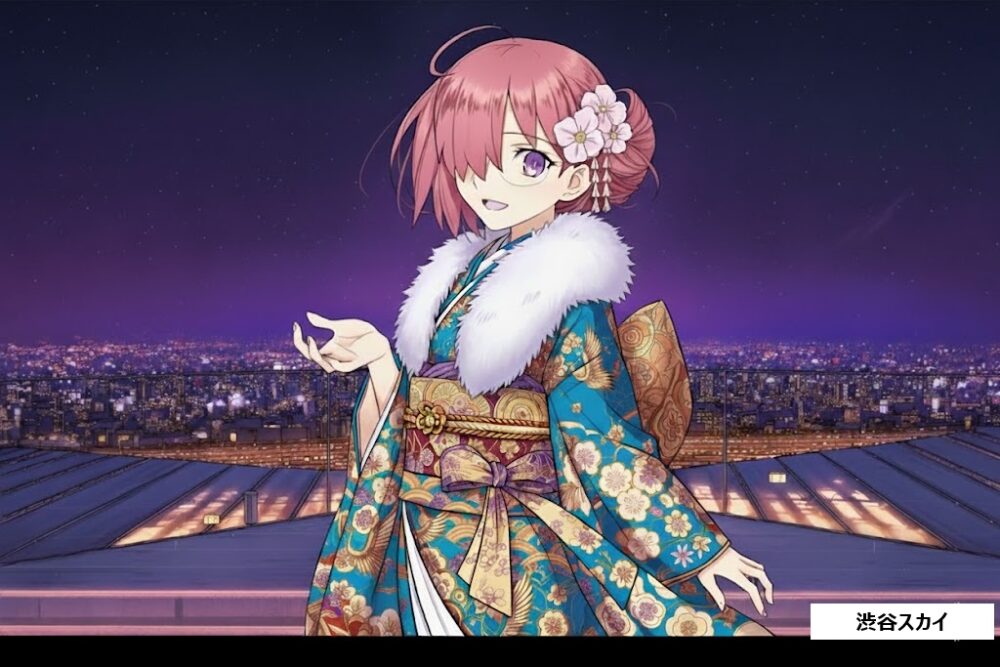
Shibuya—the beating heart of Tokyo’s youth culture and global trendsetting scene. Right in the middle of all that energy, you’ll find an experience that literally lifts you above it all: SHIBUYA SKY.
Journey to the Top of Shibuya Scramble Square
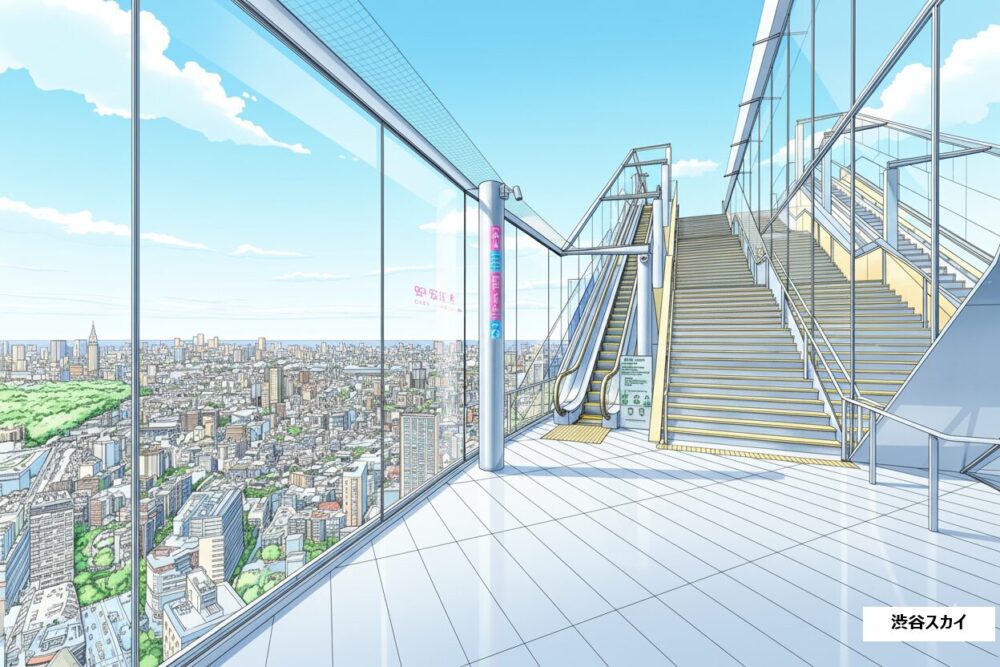
SHIBUYA SKY occupies floors 14 through 46 of Shibuya Scramble Square, a striking skyscraper connected directly to Shibuya Station. The experience is thoughtfully divided into three distinct zones:
1. SKY GATE (Floors 14-46): Your transition space as you ascend to the observation areas. Mesmerizing lighting installations build anticipation with every floor you climb.
2. SKY STAGE (Open-Air Rooftop Deck): This is where the magic happens. At 230 meters above ground, you’re standing on an entirely open-air observation deck with unobstructed 360-degree views. There’s nothing between you and the sky—just pure, exhilarating openness where you can feel the wind and breathe in the atmosphere.
3. SKY GALLERY (46th Floor Indoor Observatory): A weather-proof sanctuary where you can take in Tokyo’s vistas in comfort. This indoor space features immersive art installations and creative lighting displays that make every corner Instagram-worthy.
Taking in Tokyo’s Skyline: From Skyscrapers to Mount Fuji
From SKY STAGE, your eyes can wander across Shinjuku’s towering business district, spot both Tokyo Tower and Tokyo Skytree piercing the horizon, and on clear days, even catch a glimpse of Mount Fuji in the distance.
The view transforms throughout the day: mornings reveal the city’s dynamic energy as it awakens, late afternoon brings stunning sunsets that paint the sky in warm hues, and after dark, Tokyo becomes a glittering sea of lights stretching to the horizon.
Here’s something special: SHIBUYA SKY is the only place where you can look straight down at the famous Shibuya Scramble Crossing from above. Watching thousands of people crossing from every direction in perfect choreographed chaos? It’s mesmerizing—and yes, incredibly photogenic.
Café & Gift Shop: Completing Your Sky-High Experience
The observation area includes a stylish café where you can sip a drink while soaking in those incredible views—now that’s luxury. And don’t miss the gift shop, which is stocked with exclusive SHIBUYA SKY merchandise that you won’t find anywhere else.
SHIBUYA SKY at a Glance
| Category | Details |
|---|---|
| Name | SHIBUYA SKY |
| Location | Shibuya Scramble Square, 2-24-12 Shibuya, Shibuya-ku, Tokyo |
| Access | Direct connection to Shibuya Station Approximately 1 hour from Tokyo International Cruise Terminal |
| Height | Approximately 230 meters |
| Main Zones | SKY GATE, SKY STAGE, SKY GALLERY |
| Hours | 10:00 AM – 10:30 PM (Last entry 9:20 PM) *Hours may vary by season |
Why SHIBUYA SKY Should Be on Your Tokyo Itinerary:
・ Unbeatable access—directly connected to Shibuya Station
・ 360-degree open-air observation deck with jaw-dropping views of the entire city
・ Different experiences throughout the day: sunrise energy, golden hour sunsets, and dazzling night views
・ Perfect photo opportunities, including the iconic aerial view of Shibuya Crossing
・ Conveniently located for combining with shopping and dining in one of Tokyo’s most vibrant districts
SHIBUYA SKY offers more than just a view—it’s a chance to experience Tokyo from a perspective that few visitors get to enjoy.
Whether you’re watching the city wake up, capturing that perfect sunset shot, or marveling at the endless lights after dark, this is one experience that truly captures the essence of modern Tokyo. Make sure to add it to your shore excursion plans.
Shore Excursion: Sensō-ji Temple—Tokyo’s Spiritual Heart
No visit to Tokyo is complete without experiencing Sensō-ji Temple in Asakusa. You’ll recognize it instantly by the massive red lantern hanging at Kaminarimon (Thunder Gate). As Tokyo’s oldest Buddhist temple, Sensō-ji has been a place of worship and pilgrimage for nearly 1,400 years—and it’s still going strong today.
A 1,400-Year History and the Temple’s Sacred Deity
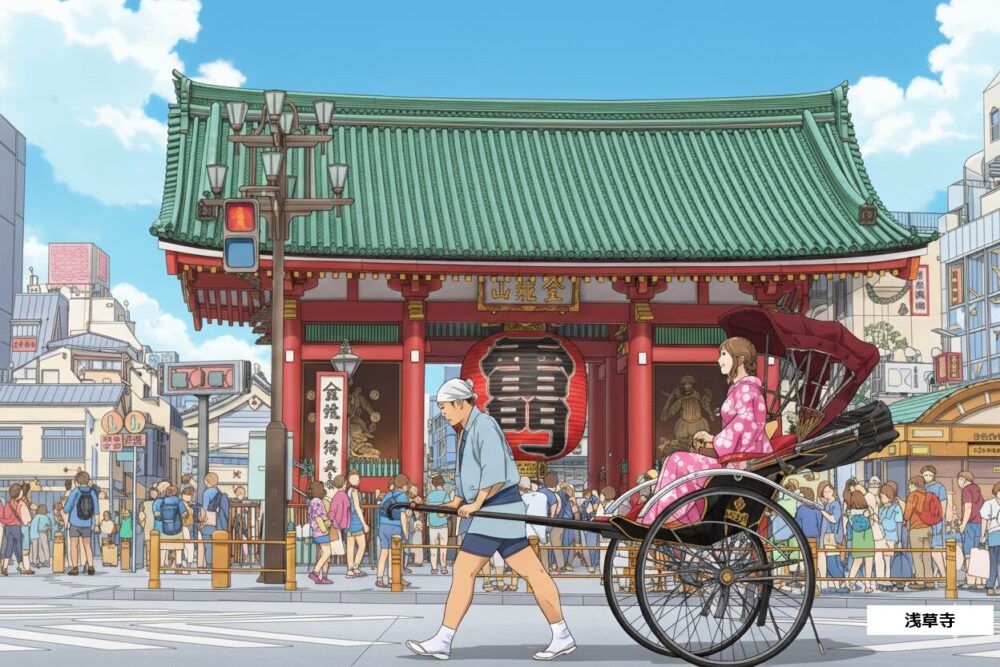
The story of Sensō-ji begins approximately 1,400 years ago, around 628 AD. The temple is dedicated to Kannon (known as Avalokiteśvara in Sanskrit), the Buddhist deity of compassion and mercy. In Japanese Buddhism, Kannon is believed to hear the prayers of all living beings, relieve suffering, grant wishes, and bring peace to troubled hearts.
Even today, countless visitors come here not just as tourists, but as pilgrims seeking solace, guidance, or simply a moment of tranquility in the midst of Tokyo’s urban energy.
Architectural Beauty and Cultural Treasures
The main hall you see today was rebuilt after World War II, but it faithfully preserves the traditional “irimoya-zukuri” architectural style—a distinctive Japanese roof design that’s both elegant and imposing. Walking through these structures, you’re experiencing centuries-old aesthetic traditions brought to life in modern times.
Keep an eye out for Nitenmon Gate on the east side of the main hall. This gate is the real deal—an original structure from the early Edo period (built in 1649) and designated as a National Important Cultural Property. After restoration work completed in 2010, the gate has regained its original vibrant vermillion color and commanding presence. Standing before it, you’re looking at a piece of authentic 17th-century Japanese architecture.
Asakusa Shrine: The “Three Guardians”
Just beyond Nitenmon Gate, you’ll find Asakusa Shrine, affectionately known locally as “Sanja-sama” (the Three Guardians). This shrine is also designated as a National Important Cultural Property and works in harmony with Sensō-ji Temple to preserve the spiritual and cultural heritage of this neighborhood.
Here’s an interesting cultural note: you’ll notice both a Buddhist temple and a Shinto shrine coexisting peacefully in the same complex. This religious harmony is quintessentially Japanese—many Japanese people practice both Buddhism and Shintoism without seeing any contradiction.
Making the Most of Your Visit
The approach to the temple, called Nakamise Street, is an experience in itself. This 250-meter shopping street is lined with traditional shops selling everything from handmade wagashi (Japanese sweets) and souvenirs to yukata (casual summer kimono) and folding fans. Just strolling through immerses you in Japanese culture—the sights, sounds, and even the smells of traditional Japan.

Visit after sunset if you can. The illuminated main hall and five-story pagoda create an almost magical atmosphere that’s completely different from the daytime bustle.
The golden glow against the night sky is stunning, and you’ll find the crowds are somewhat thinner too.
Sensō-ji Temple at a Glance
| Category | Details |
|---|---|
| Name | Sensō-ji Temple |
| Location | 2-3-1 Asakusa, Taito-ku, Tokyo |
| Access | 5-minute walk from Asakusa Station (Tokyo Metro Ginza Line / Tobu Skytree Line) Approximately 1 hour from Tokyo International Cruise Terminal |
| Founded | Circa 628 AD (Empress Suiko era) |
| Principal Deity | Kannon (Goddess of Mercy) |
| Cultural Properties | Nitenmon Gate and Asakusa Shrine (National Important Cultural Properties) |
| Must-See | Kaminarimon Gate, Main Hall, Five-Story Pagoda, Nakamise Street, Asakusa Shrine |
Why Sensō-ji Temple Deserves a Spot on Your Itinerary:
・ Tokyo’s oldest Buddhist temple with nearly 1,400 years of continuous history
・ A living place of worship where you can witness authentic Japanese spiritual practices
・ Authentic Edo-period architecture preserved as National Cultural Properties
・ The vibrant Nakamise Street offers an immersive cultural shopping experience
Sensō-ji is more than just a tourist attraction—it’s Tokyo’s spiritual origin point, where Japanese faith and tradition continue to thrive in the modern age.
Whether you come seeking spiritual reflection, cultural immersion, or simply to experience one of Tokyo’s most iconic locations, this temple has a way of leaving visitors feeling centered and enriched. It’s the kind of place that adds genuine depth to your Tokyo experience.
Shore Excursion: Tokyo Skytree Town
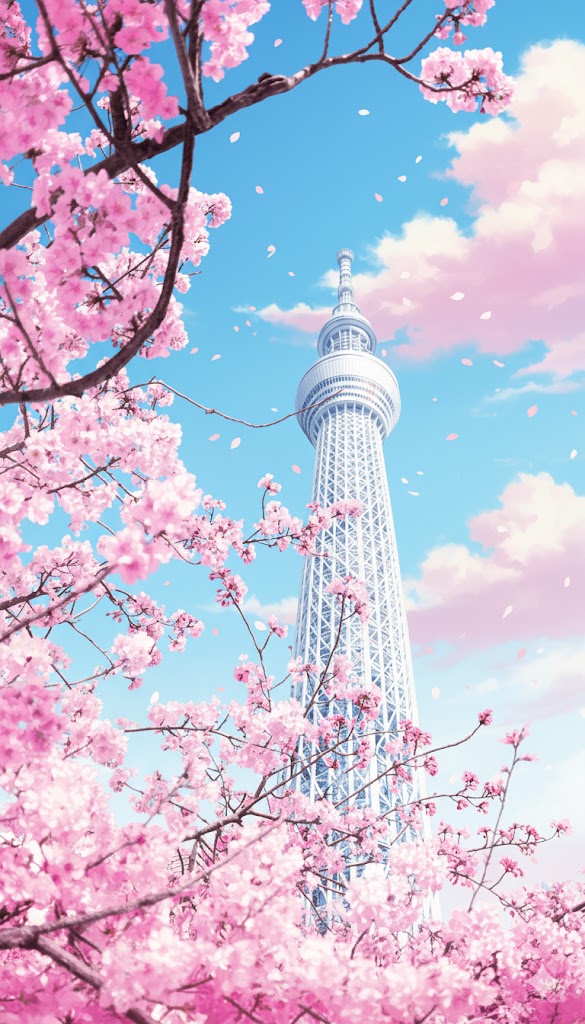
The World’s Tallest Freestanding Tower: Tokyo’s Modern Icon
Tokyo Skytree Town has quickly become one of Tokyo’s most beloved landmarks since its opening. Centered around the towering 634-meter Tokyo Skytree, this isn’t just an observation tower—it’s an entire entertainment district where world-class views meet shopping, dining, and cultural experiences all in one place.
Tokyo Skytree: Reaching for the Sky at 634 Meters
Here’s something impressive: Tokyo Skytree holds the title of world’s tallest freestanding tower at 634 meters (that’s over 2,000 feet). The tower features two observation levels—the Tembo Deck at 350 meters and the even more spectacular Tembo Galleria at 450 meters. From either vantage point, you’re treated to 360-degree panoramas of Tokyo, and on crystal-clear days, Mount Fuji appears on the horizon like a perfect painting.
But the experience goes beyond just the views. Inside the tower, you’ll find stylish cafés, restaurants, and gift shops stocked with exclusive Skytree merchandise you won’t find anywhere else.
The real showstopper, though? The nightly illuminations. Tokyo Skytree cycles through three distinct lighting designs—each with its own aesthetic inspired by traditional Japanese concepts: “Iki” (chic sophistication), “Miyabi” (refined elegance), and “Nobori” (dynamic energy). The colors change daily, so even if you’ve seen it before, there’s always something new to photograph.
Tokyo Solamachi: A Shopping Village in the Sky
At the base of the tower, you’ll find Tokyo Solamachi—a sprawling retail complex with over 300 shops and restaurants spread across multiple floors. Think of it as a self-contained shopping village where you can find everything from high-end fashion and artisan crafts to Tokyo-exclusive souvenirs and gourmet treats.
What I particularly love about Solamachi is how it blends contemporary retail with traditional Japanese design elements. You’ll notice subtle nods to Japanese aesthetics throughout—it’s shopping with a distinctly Tokyo flavor. Perfect for picking up those special gifts or treating yourself to something memorable.
Entertainment Meets Art: Aquarium and Planetarium
Tokyo Skytree Town isn’t just about views and shopping. The complex includes two unique attractions that elevate the experience:
Sumida Aquarium is unlike any aquarium you’ve probably visited. Yes, you’ll see adorable penguins and the ever-popular garden eels, but what sets this place apart is its artistic approach. The lighting, spatial design, and presentation transform the aquarium into something more akin to an immersive art installation. It’s both calming and captivating—genuinely Instagram-worthy in the best way.
Tenku Planetarium offers a different kind of escape. Their state-of-the-art projection system recreates the night sky with stunning realism, providing a peaceful retreat from the urban energy outside. It’s a contemplative experience that complements the tower’s soaring views beautifully.
Tokyo Skytree Town at a Glance
| Category | Details |
|---|---|
| Name | Tokyo Skytree Town |
| Main Facilities | Tokyo Skytree, Tokyo Solamachi, Sumida Aquarium, Tenku Planetarium |
| Location | 1-1-2 Oshiage, Sumida-ku, Tokyo |
| Tower Height | 634 meters (world’s tallest freestanding tower) |
| Access | Direct connection to “Tokyo Skytree Station” (Tobu Skytree Line) or “Oshiage Station” (Tokyo Metro Hanzomon Line) Approximately 1 hour from Tokyo International Cruise Terminal |
| Highlights | Observation decks, nightly illuminations, shopping, dining, aquarium, planetarium |
Why Tokyo Skytree Town Should Be on Your List:
・ Tokyo’s premier destination combining spectacular views, entertainment, and shopping
・ World-record-breaking observation decks offering unparalleled city panoramas
・ Nightly illuminations that change daily—always something new to see
・ Perfect for all types of travelers: families, couples, and solo adventurers alike
・ A complete experience where you can easily spend half a day or more
Tokyo Skytree Town embodies everything that makes modern Tokyo exciting: breathtaking views, cutting-edge entertainment, world-class shopping, and artistic experiences all wrapped into one spectacular destination.
Whether you visit during the day to catch those clear views of Mount Fuji or return at night to see the tower’s magical illuminations, you’re experiencing Tokyo at its most dynamic. It’s the kind of place that offers something different every time you visit—and trust me, you’ll want to come back.
Shore Excursion: Kabukiza Theatre
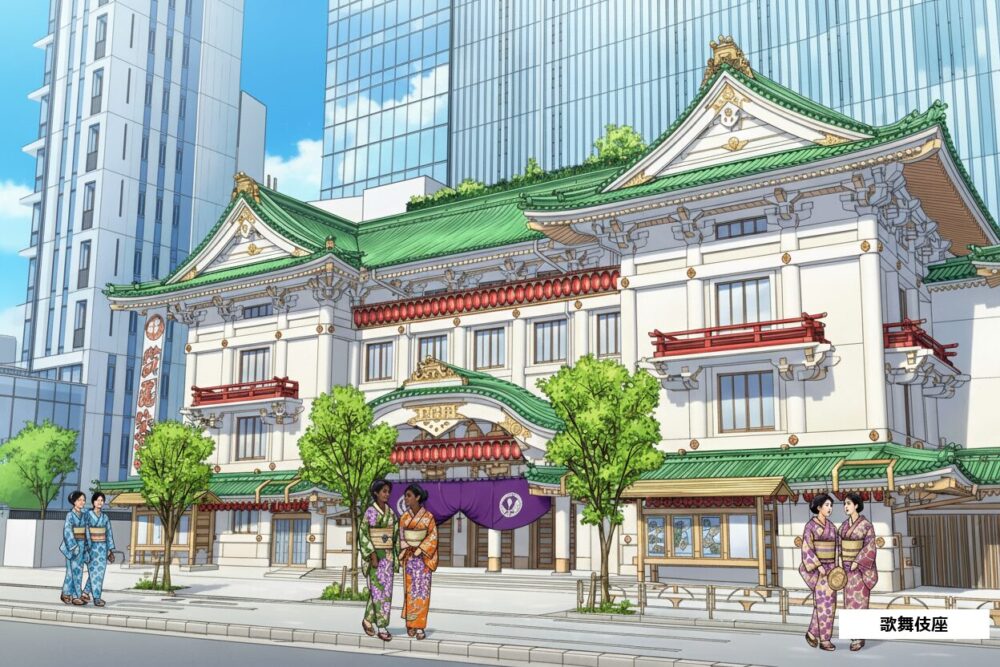
Where History and Beauty Converge: Ginza’s Cultural Landmark
Located in the heart of Tokyo’s upscale Ginza district, Kabukiza Theatre is Japan’s premier venue dedicated exclusively to kabuki—a traditional form of Japanese theater that dates back over 400 years.
The original Kabukiza opened its doors in 1889, and for more than 130 years, it has remained the beating heart of Japan’s theatrical tradition. The current building, which opened in 2013, is actually the fifth generation of the theater. What makes it special is how seamlessly it blends classical Japanese architectural beauty with modern functionality—it’s a stunning visual statement that honors the past while embracing the present.
Experiencing Kabuki: Easier Than You Think
Now, I know what you might be thinking: “Traditional Japanese theater? That sounds intimidating.” But here’s the thing—Kabukiza makes it remarkably accessible, even for first-timers and international visitors.
They offer something called “Hitomaku-mi-seki” (single-act tickets), which means you can experience just one act of a performance rather than committing to a full show. It’s a perfect introduction to this art form.
What you’ll witness is truly spectacular: elaborate costumes that shimmer with gold and silk, distinctive vocal techniques passed down through generations, ingenious stage mechanisms (some plays feature actors appearing through trap doors or “flying” across the stage), and live traditional music that heightens every emotion.
Don’t worry about the language barrier—the theater provides English subtitle screens and audio guide devices that explain the story as it unfolds. You’ll be surprised how much you can appreciate the artistry even without understanding Japanese. The visual storytelling, the dramatic poses (called “mie”), and the sheer theatricality transcend language.
Kobikicho Square: Shopping and Dining Underground
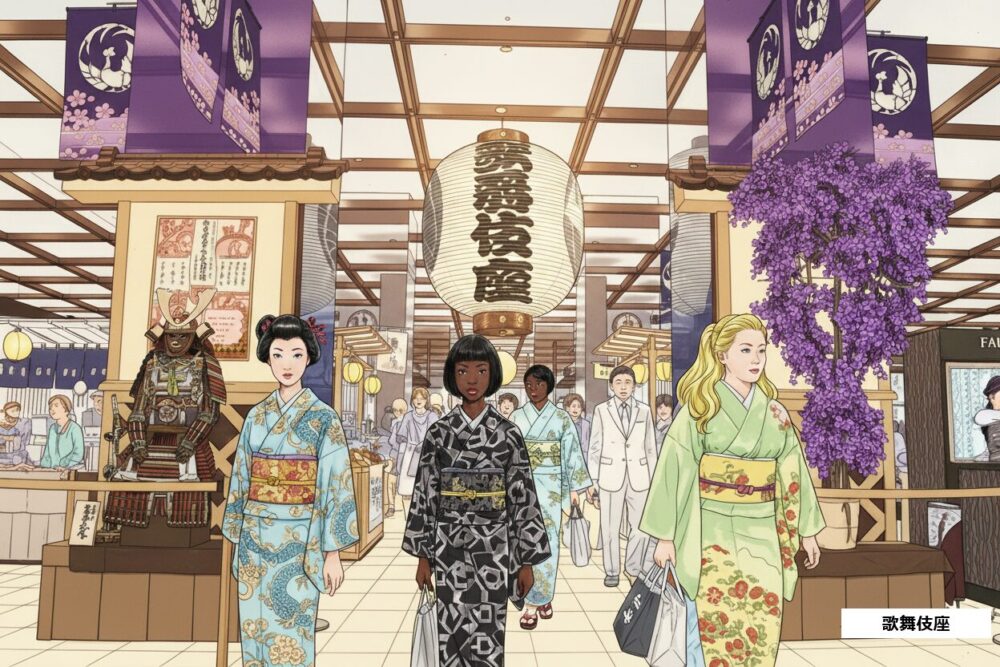
On the theater’s basement level 2, you’ll discover Kobikicho Square—an open public space that’s become a destination in itself.
This area is a treasure trove for kabuki enthusiasts and souvenir hunters alike. You’ll find everything from actor merchandise and kabuki-themed crafts to exclusive sweets and traditional confections you can only get here. It’s the kind of place where even people who aren’t attending a performance love to browse.
Here’s what I appreciate about this setup: you don’t need a theater ticket to explore Kobikicho Square. It’s open to the public, making it a perfect stop during your Ginza shopping expedition. Grab a coffee, pick up some unique gifts, and soak in the kabuki atmosphere without committing to a full performance.
Dining and Tea Rooms: Traditional Ambiance
The theater complex includes several dining options where you can enjoy traditional Japanese cuisine and light meals in an atmosphere that complements the theatrical experience. There are also tea rooms perfect for relaxing between acts or simply savoring a quiet moment in elegant, traditional surroundings.
Kabukiza Theatre at a Glance
| Category | Details |
|---|---|
| Name | Kabukiza Theatre |
| Location | 4-12-15 Ginza, Chuo-ku, Tokyo |
| Opened | 1889 (Original building) |
| Current Building | Completed 2013 (5th generation) |
| Main Facilities | Theater, Kobikicho Square, restaurants, tea rooms |
| Access | Direct connection to Higashi-Ginza Station (Tokyo Metro Hibiya Line / Toei Asakusa Line) Approximately 50 minutes from Tokyo International Cruise Terminal |
| Features | Dedicated kabuki theater, traditional Japanese architectural design, fusion of tradition and modernity |
Why Kabukiza Theatre Deserves Your Time:
・ Experience 400 years of theatrical tradition in kabuki’s most prestigious venue
・ Accessible to beginners with single-act tickets and English subtitle/audio guide systems
・ Kobikicho Square offers unique souvenirs, sweets, and kabuki merchandise (no ticket required)
・ Located in Ginza, Tokyo’s premier luxury shopping district—easy to combine with other activities
・ Located in Ginza, Tokyo’s premier luxury shopping district—easy to combine with other activities
Kabukiza Theatre is where Japan’s traditional soul meets contemporary sophistication. Whether you choose to witness the full spectacle of a kabuki performance or simply explore the cultural offerings of Kobikicho Square, you’re stepping into a living tradition that has captivated audiences for centuries.
In Ginza’s polished streets, Kabukiza stands as a reminder that Tokyo’s true luxury isn’t just about shopping—it’s about experiencing art forms that have been refined over generations. Give yourself this cultural gift during your Tokyo visit.
Shore Excursion: Tsukiji Outer Market

Tsukiji Market was once known as “Japan’s Kitchen.” Even after the market functions relocated to Toyosu in 2018, Tsukiji Outer Market continues to thrive as a vibrant center of food culture, drawing crowds of visitors every day.
A Food Wonderland: 400 Specialty Shops
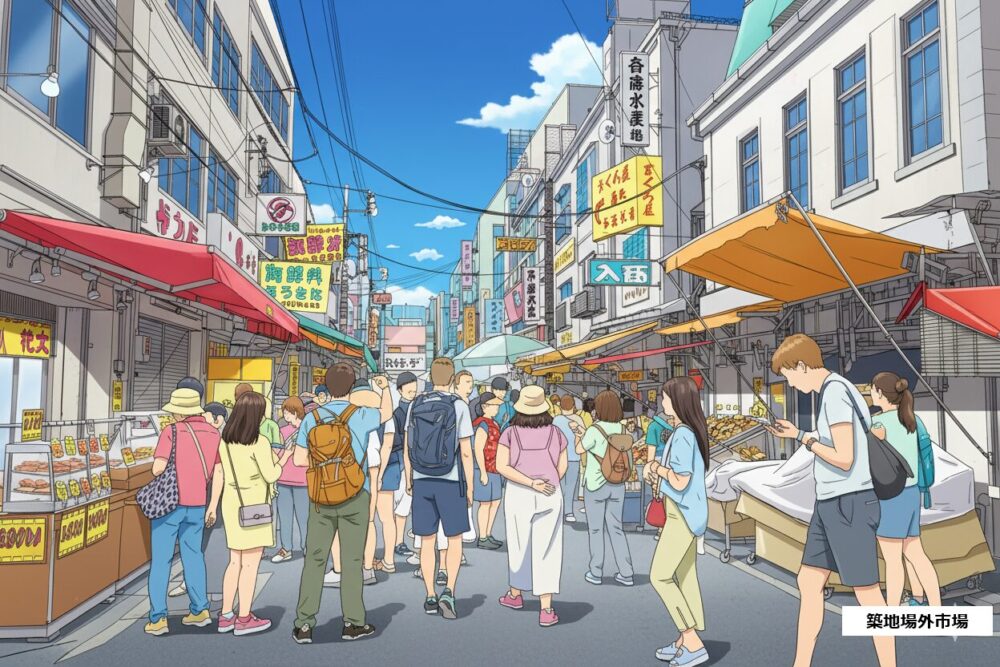
Tsukiji Outer Market currently operates approximately 400 specialty shops. From fresh seafood, meat, and vegetables to professional-grade knives, cooking utensils, and tableware, the market offers an authentic selection that attracts even professional chefs.
Many shops welcome casual visitors, making this a “food theme park” where simply walking around and browsing is thoroughly enjoyable.
Savoring Tsukiji’s Exceptional Cuisine
When it comes to Tsukiji, fresh seafood is the star. The outer market is home to numerous sushi restaurants and eateries serving dishes made with the day’s catch—including seafood rice bowls, tamagoyaki (rolled omelet), and fried delicacies.
From sushi sets perfect for breakfast to light snacks ideal for eating as you explore, you can fully enjoy Tsukiji’s culinary offerings.
A Global Destination for Food Culture

Tsukiji Outer Market is also recognized as a place that showcases Japanese food culture to the world.
The market attracts many international travelers, offering them the opportunity to experience the depth of “Japanese cuisine” through fresh ingredients and traditional cooking tools.
Tsukiji Outer Market Information
| Category | Details |
|---|---|
| Name | Tsukiji Outer Market |
| Location | Tsukiji 4-chome area, Chuo-ku, Tokyo |
| Access | Approximately 1-minute walk from Tsukiji Station (Tokyo Metro Hibiya Line) Approximately 3-minute walk from Tsukijishijo Station (Toei Oedo Line) Approximately 40 minutes from Tokyo International Cruise Terminal |
| Business Hours | Varies by shop; generally centered around 5:00 AM to 2:00 PM |
| Closed | Sundays, national holidays, market closure days (varies by shop) |
| Main Products | Fresh fish, produce, meat, dried goods, seasonings, sushi, seafood bowls, knives, tableware, cooking utensils, etc. |
| Features | Approximately 400 shops continue operating after the wholesale market moved to Toyosu; popular commercial area for tourists and professional chefs |
| History | Tsukiji Market established in 1935. After the wholesale market relocated to Toyosu in 2018, the outer market continues as a commercial area |
| Nearby Attractions | Tsukiji Honganji Temple (walking distance) |
Conclusion: Enjoy Tokyo from Tokyo International Cruise Terminal!
スターブリーズ、東京国際クルーズターミナル出港のタイムラプス pic.twitter.com/HbmTLPqAvN
— PUNIP cruises(プニップ・クルーズ)中村 辰美 (@punipcruises) April 16, 2023
In this article, we’ve covered Your Complete Guide to Tokyo International Cruise Terminal: Address, Station Access & What’s Nearby.
From easy access routes and transportation options to nearby attractions in Odaiba and exciting shore excursions throughout Tokyo, you now have everything you need to make your cruise experience smooth and memorable. Whether you’re exploring historic temples, savoring fresh seafood at Tsukiji, or taking in panoramic views from observation decks, Tokyo offers countless ways to enrich your journey.
We hope this guide helps you start your voyage with confidence and excitement. Enjoy your time in Tokyo!
Looking to book shore excursions for your cruise? These are the services I recommend:
- japanshoreexcursions.com
- shoreexcursions.asia
- vietnamshoreexcursions.asia
- chinashoreexcursion.com
- globalshoreexcursions.com

If you’re curious to learn more about what makes these Japan-based cruises so special, I’ve put together detailed articles on each one—feel free to check them out!
 The Best Japan Cruises 2026: An Insider's Guide to Unforgettable Cultural Experiences
If you're planning a cruise from Japan, you might be wondering: Want to experience authentic Japanese culture and festivals—but not sure where to start? Wondering when's the best time to cruise Japan? Curious if you'll actually get to explore those historic sites you've been dreaming about? If you try looking at cruise line websites, you'll find that very few of…
The Best Japan Cruises 2026: An Insider's Guide to Unforgettable Cultural Experiences
If you're planning a cruise from Japan, you might be wondering: Want to experience authentic Japanese culture and festivals—but not sure where to start? Wondering when's the best time to cruise Japan? Curious if you'll actually get to explore those historic sites you've been dreaming about? If you try looking at cruise line websites, you'll find that very few of…
 The Ultimate Guide to Cruises Around Japan: Luxury, Culture, and Everything in Between
If you're planning a cruise from Japan, you might be wondering: Hokkaido's nature, Kyoto's temples, Kyushu's hot springs—I want it all, but how? Japan has so much to see, but who wants to spend their vacation packing and unpacking at every stop? "I want to relax AND see Japan's best. Is that too much to ask? You're not alone—and I'm…
The Ultimate Guide to Cruises Around Japan: Luxury, Culture, and Everything in Between
If you're planning a cruise from Japan, you might be wondering: Hokkaido's nature, Kyoto's temples, Kyushu's hot springs—I want it all, but how? Japan has so much to see, but who wants to spend their vacation packing and unpacking at every stop? "I want to relax AND see Japan's best. Is that too much to ask? You're not alone—and I'm…
 Diamond Princess Japan 2026: Compare Cruise Plans, Prices & Itineraries
If you're planning a cruise from Japan, you might be wondering: I keep hearing about Princess Cruises for Japan—but is it really worth it? I only have limited vacation time—which itinerary will let me see the most important parts of Japan? I'm worried about the language barrier and cultural differences—will a cruise make Japan more accessible for me? If any…
Diamond Princess Japan 2026: Compare Cruise Plans, Prices & Itineraries
If you're planning a cruise from Japan, you might be wondering: I keep hearing about Princess Cruises for Japan—but is it really worth it? I only have limited vacation time—which itinerary will let me see the most important parts of Japan? I'm worried about the language barrier and cultural differences—will a cruise make Japan more accessible for me? If any…
 Celebrity Millennium Japan 2026: Compare Cruise Plans, Prices & Itineraries
If you're planning a cruise from Japan, you might be wondering: I keep hearing about Celebrity Cruises for Japan—but is it really worth it? I only have limited vacation time—which itinerary will let me see the most important parts of Japan? I'm worried about the language barrier and cultural differences—will a cruise make Japan more accessible for me? If any…
Celebrity Millennium Japan 2026: Compare Cruise Plans, Prices & Itineraries
If you're planning a cruise from Japan, you might be wondering: I keep hearing about Celebrity Cruises for Japan—but is it really worth it? I only have limited vacation time—which itinerary will let me see the most important parts of Japan? I'm worried about the language barrier and cultural differences—will a cruise make Japan more accessible for me? If any…
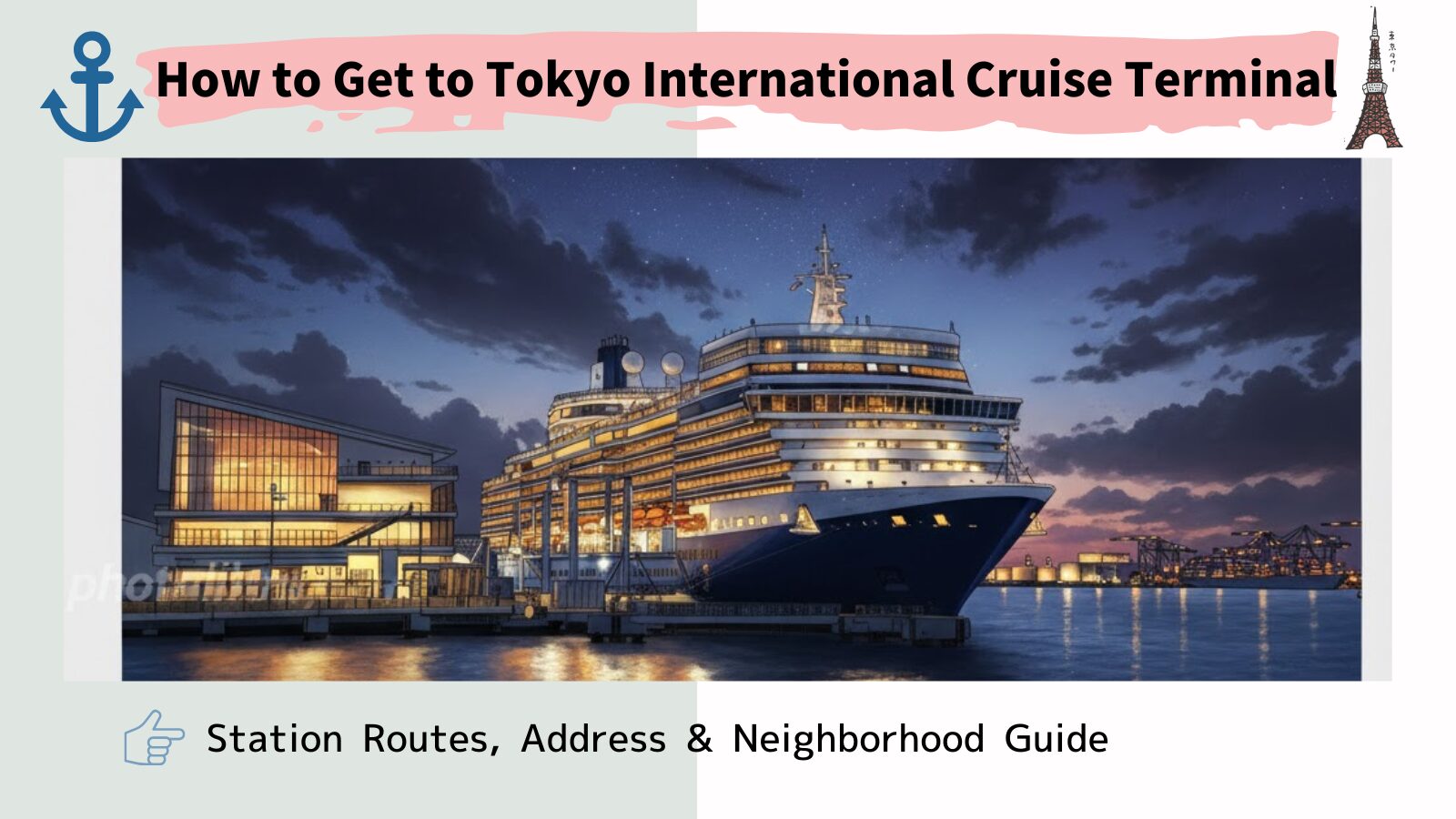 Your Complete Guide to Tokyo International Cruise Terminal: Address, Station Access & What's Nearby
If you're planning a cruise from Tokyo, you might be wondering: How do I navigate a foreign city with a language barrier? What's the easiest way to find the cruise terminal without getting lost? Where can I discover memorable spots near the terminal to make my visit truly special? You're not alone—and I'm here to help. Tokyo International Cruise Terminal…
Your Complete Guide to Tokyo International Cruise Terminal: Address, Station Access & What's Nearby
If you're planning a cruise from Tokyo, you might be wondering: How do I navigate a foreign city with a language barrier? What's the easiest way to find the cruise terminal without getting lost? Where can I discover memorable spots near the terminal to make my visit truly special? You're not alone—and I'm here to help. Tokyo International Cruise Terminal…
I’d love to help you experience Japan in this unique way. Let’s make it happen together!

I’ll keep sharing insider tips and updates about cruising in Japan, so please stop by again soon! I’m here to help you discover the best of Japan. Let’s explore together!
Happy cruising!– , Cruise Aoi